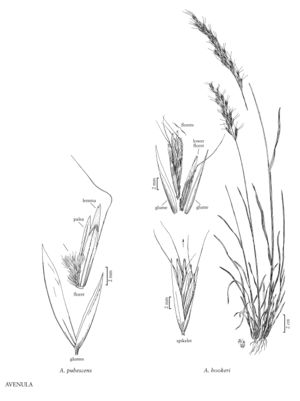Difference between revisions of "Avenula hookeri"
FNA>Volume Importer |
FNA>Volume Importer |
||
| Line 20: | Line 20: | ||
-->{{Treatment/Body | -->{{Treatment/Body | ||
|distribution=Colo.;N.Mex.;Minn.;N.Dak.;Alta.;B.C.;Man.;N.W.T.;Que.;Sask.;Yukon;Mont.;Vt.;Wyo.;S.Dak. | |distribution=Colo.;N.Mex.;Minn.;N.Dak.;Alta.;B.C.;Man.;N.W.T.;Que.;Sask.;Yukon;Mont.;Vt.;Wyo.;S.Dak. | ||
| − | |discussion=<p | + | |discussion=<p>Avenula hookeri grows on mesic to dry, open prairie slopes, hillsides, forest openings, and meadows, in montane to subalpine zones, from the Yukon and Northwest Territories to northern New Mexico.</p> |
|tables= | |tables= | ||
|references= | |references= | ||
| Line 36: | Line 36: | ||
|basionyms= | |basionyms= | ||
|family=Poaceae | |family=Poaceae | ||
| + | |illustrator=Linda A. Vorobik and Hana Pazdírková | ||
|distribution=Colo.;N.Mex.;Minn.;N.Dak.;Alta.;B.C.;Man.;N.W.T.;Que.;Sask.;Yukon;Mont.;Vt.;Wyo.;S.Dak. | |distribution=Colo.;N.Mex.;Minn.;N.Dak.;Alta.;B.C.;Man.;N.W.T.;Que.;Sask.;Yukon;Mont.;Vt.;Wyo.;S.Dak. | ||
|reference=None | |reference=None | ||
| Line 41: | Line 42: | ||
|publication year= | |publication year= | ||
|special status= | |special status= | ||
| − | |source xml=https:// | + | |source xml=https://bibilujan@bitbucket.org/aafc-mbb/fna-data-curation.git/src/314eb390f968962f596ae85f506b4b3db8683b1b/coarse_grained_fna_xml/V24/V24_988.xml |
|subfamily=Poaceae subfam. Pooideae | |subfamily=Poaceae subfam. Pooideae | ||
|tribe=Poaceae tribe Poeae | |tribe=Poaceae tribe Poeae | ||
Revision as of 16:10, 30 October 2019
Plants cespitose, not stoloniferous. Culms 10-75 cm, erect. Sheaths closed for less than 1/3 their length, smooth to scabridulous; ligules 3-7 mm, acute, usually lacerate; blades usually 4-20 cm long, 1-4.5 mm wide, smooth to scabridulous, margins cartilaginous and whitish. Panicles (4)6-11(13) cm long, usually 0.8-2.5 cm wide, erect or ascending; branches 10-25 mm, usually straight, stiff, usually with 1-2 spikelets. Spikelets 12-16 mm, with 3-6 florets; rachilla internodes usually 1.5-2.5 mm, hairs 0.2-1.5 mm. Glumes thin, acute; lower glumes 9-13 mm, 3-veined; upper glumes 9-14 mm, 3-5-veined; calluses bearded, hairs usually shorter than 1 mm; lemmas 10-12 mm, awned, awns 10-17 mm, flattened below the bend; paleas 6-8.75 mm; anthers 2.5-5 mm. 2n = 14.
Distribution
Colo., N.Mex., Minn., N.Dak., Alta., B.C., Man., N.W.T., Que., Sask., Yukon, Mont., Vt., Wyo., S.Dak.
Discussion
Avenula hookeri grows on mesic to dry, open prairie slopes, hillsides, forest openings, and meadows, in montane to subalpine zones, from the Yukon and Northwest Territories to northern New Mexico.
Selected References
None.
